Hyperspectral Academy
Learning

1. Introduction to Hyperspectral Imaging
1.1. What is Hyperspectral Imaging?
Every pixel in a hyperspectral image contains a detailed spectral signature, akin to a chemical fingerprint of the material below. But to truly understand what makes hyperspectral imaging so powerful, we need to look at how it captures data differently from conventional sensors.
Hyperspectral imaging (HSI) is an advanced remote sensing technique allowing us to see the world in greater detail than most conventional satellite sensors can perceive. Fundamentally, HSI captures image data across hundreds of narrow, contiguous spectral bands, spanning the visible, near-infrared (VNIR), and shortwave infrared (SWIR) regions of the electromagnetic spectrum—typically ranging from 400 to 2500 nanometers.
While most commercial space-borne HSI systems, including Pixxel’s, focus on the VNIR and SWIR regions, hyperspectral sensors can extend into the thermal infrared (TIR) range in specialised airborne or lab-based setups, enabling applications in heat detection, gas analysis, and thermal emissivity studies.
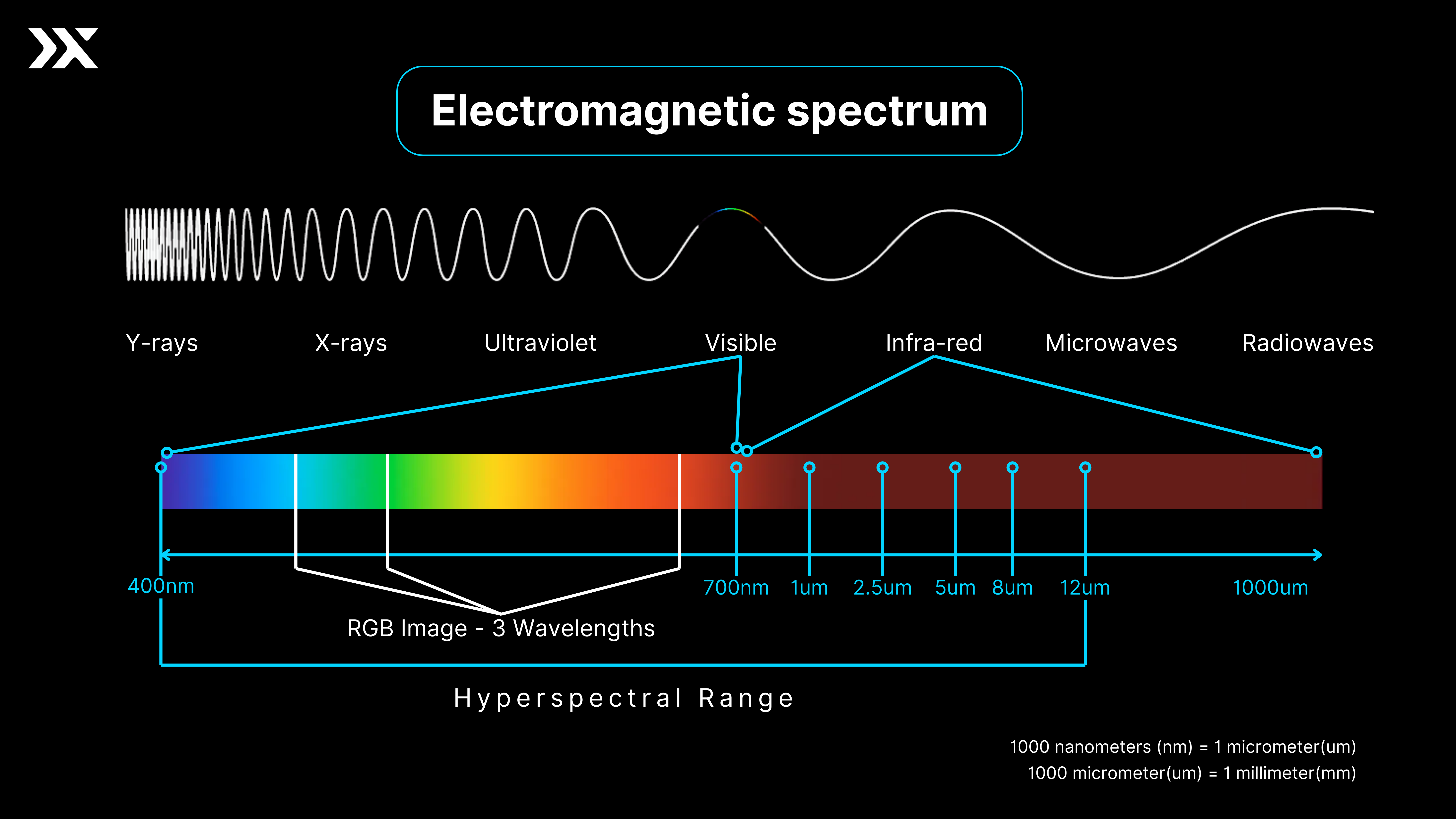
Unlike traditional imaging systems that capture red, green, and blue (RGB) or multispectral systems that capture 4 to 10 broader bands, hyperspectral sensors collect data in narrow spectral intervals—between 1 and 10 nanometers. This enables HSI to detect subtle differences in how materials reflect light, offering extraordinary insight into their chemical and physical properties.
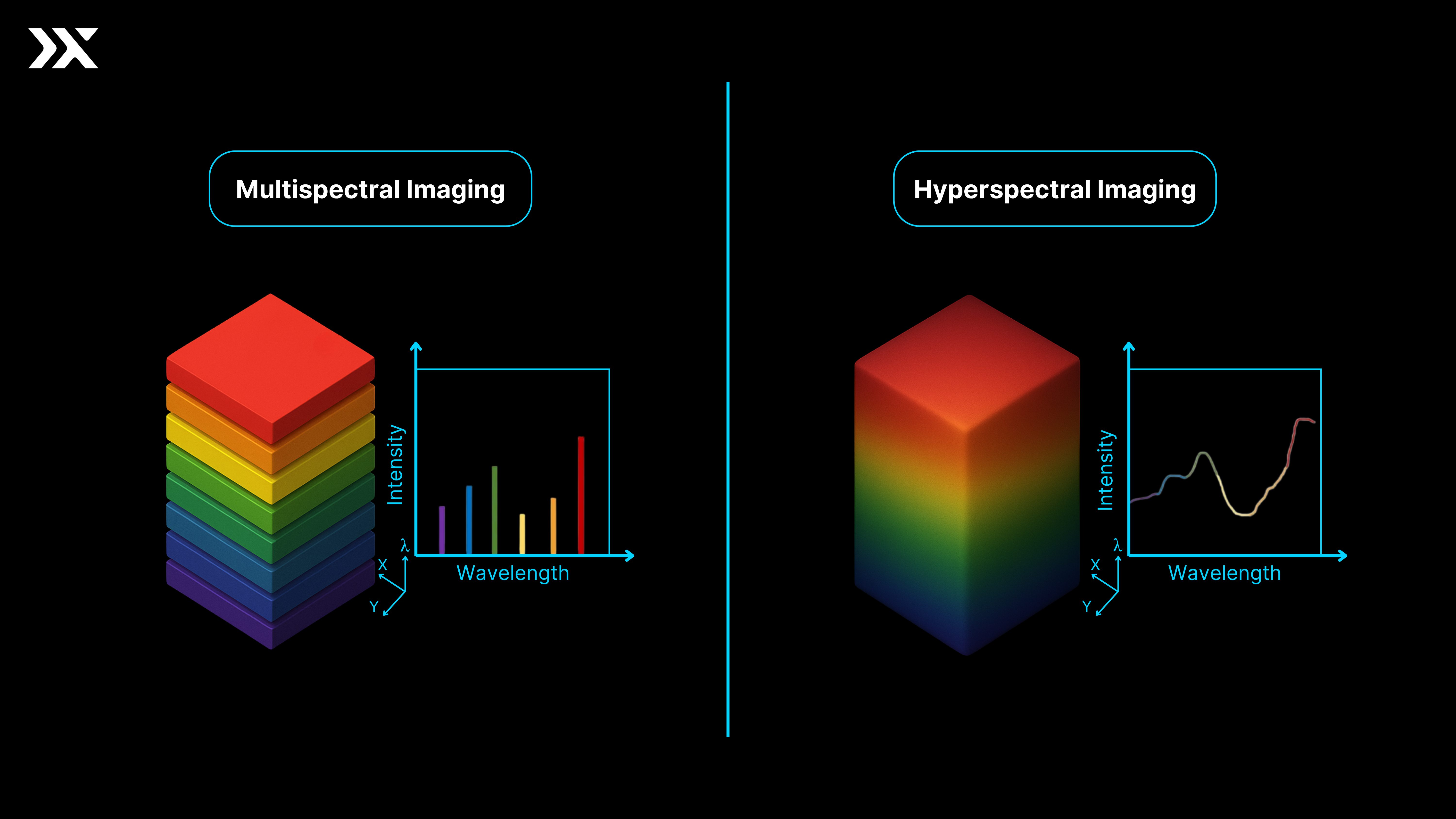
While multispectral systems might tell you “this is vegetation,” hyperspectral systems can say “this is nutrient-deficient maize under heat stress.”
1.1.1. Hyperspectral vs. Multispectral vs. RGB
To understand what sets HSI apart, it helps to compare it with more familiar remote sensing systems like multispectral and RGB imaging. Each type captures Earth’s surface in a different way. The difference comes down to how many spectral bands are collected, how narrow those bands are, and what level of detail they reveal about the materials within each pixel.
Remote sensing systems vary in the number of spectral bands they capture and the level of detail they reveal about Earth’s surface. RGB imaging is the most basic form, capturing three broad bands (Red, Green, and Blue) that align with human vision. Multispectral imaging (MSI) improves upon this by capturing reflectance in several discrete bands—typically 4 to 10—extending into the near-infrared (NIR) spectrum. HSI, however, significantly advances spectral analysis by capturing dozens to hundreds of contiguous narrow bands across the visible, NIR, and shortwave infrared (SWIR) regions, unlocking highly detailed spectral fingerprints for every pixel.
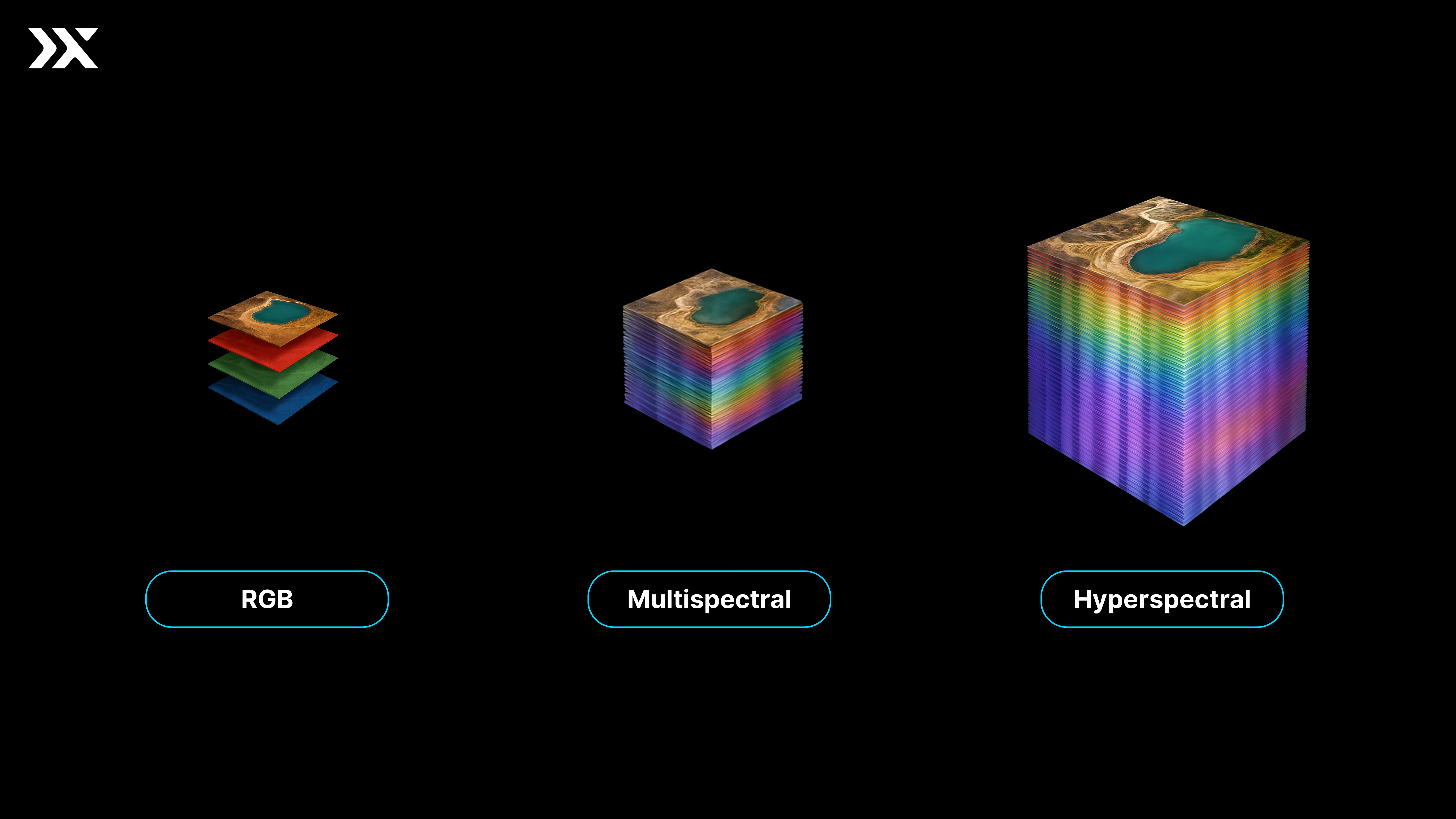
This progression—from RGB to MSI to HSI—represents a shift from visual inspection to precision material analysis, enabling applications ranging from environmental monitoring to mineral exploration and precision agriculture.
.png)
1.2. The Physics Behind Hyperspectral Imaging
Hyperspectral imaging is based on the physics of electromagnetic reflectance, i.e., the way materials absorb and reflect specific wavelengths of light. When sunlight interacts with the Earth’s surface, each object reflects a unique pattern of light across the electromagnetic spectrum.
Every pixel in a hyperspectral image contains rich spectral detail, but to truly understand what makes hyperspectral data so powerful, it's essential to grasp a few key concepts in spectrometry.
1.2.1. The Electromagnetic Spectrum, Bands, and Spectral Resolution
Hyperspectral sensors collect data across a continuous portion of the electromagnetic spectrum (EMS), typically spanning the Visible and Near Infrared (VNIR), Shortwave Infrared, and in some cases, the Thermal Infrared (TIR).
Each pixel in a hyperspectral image contains a reflectance spectrum: a detailed curve showing how that material interacts with light across the EMS, which can be analysed to determine material composition. To understand the richness of this information, it’s important to know how bands, spectral resolution, and bandwidth shape the data.
Together, spectral band positioning, resolution, and FWHM determine how well a hyperspectral sensor can detect fine variations in reflectance, essential for analysing the Earth’s surface.
Not all hyperspectral sensors are designed with equally spaced or uniformly wide bands. Some systems, such as Pixxel’s Firefly constellation, are optimised with variable bandwidths to enhance detection of specific features in different parts of the spectrum.
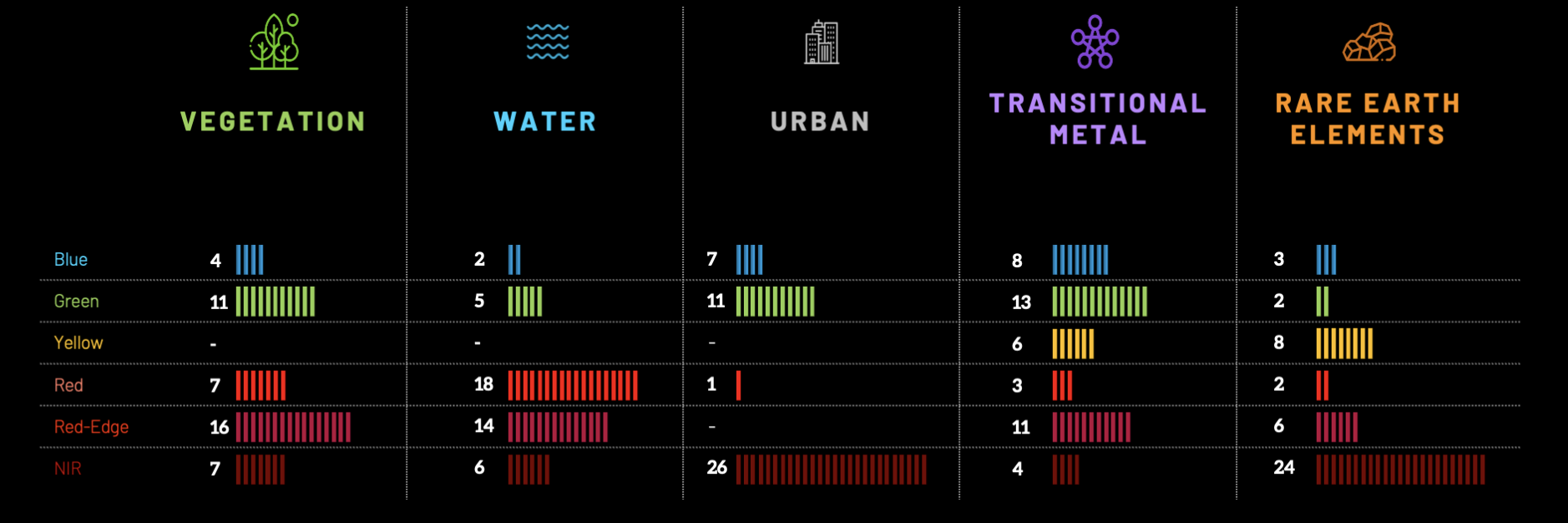
HSI is also called an imaging spectrometry technique, merging two capabilities: the spatial resolution of imaging and the compositional insight of spectroscopy. This dual nature means hyperspectral data answers both "Where is something?" and "What is it made of?"
1.2.2. VNIR, SWIR, and TIR regions
Hyperspectral sensors often span one or more of the following spectral regions, each revealing unique information:
Each of these regions reveals different physical and chemical properties of Earth's surface materials. For example, while VNIR is responsive to surface reflectance from vegetation and water, SWIR provides deeper compositional insight—such as whether a crop is water-stressed or if a rock contains clay minerals. TIR, though less common in hyperspectral imaging due to detector limitations, is valuable for studying temperature gradients and emissivity differences.
Advanced hyperspectral sensors can capture combinations of these regions in a single system, enabling multi-domain insights from vegetation health to thermal anomalies.
1.3. Components of a Hyperspectral System
1.3.1. Sensors and Platforms
Hyperspectral imaging systems can be deployed on different platforms, selected based on the target application, spatial scale, and desired resolution:
- Spaceborne platforms including NASA’s EMIT sensor and Pixxel’s Firefly satellites are ideal for large-scale area monitoring. Pixxel’s constellation, for instance, delivers a 5-metre ground sampling distance (GSD), with a swath of 40 km, and fine spectral resolution, supporting monitoring at commercially viable scales.
- Airborne sensors such as AVIRIS (Airborne Visible/Infrared Imaging Spectrometer) and HYDICE (Hyperspectral Digital Imagery Collection Experiment) are used for regional, high-resolution studies. These sensors are typically flown on aircraft or drones for more targeted missions.
- UAV-mounted and handheld systems are popular for local-scale studies, offering flexibility and frequent deployment for agricultural monitoring, environmental assessments, and lab-based applications.
One of the defining differences between hyperspectral and other imaging technologies is its ability to go beyond appearance. Traditional cameras or even multispectral sensors might be able to tell you that a region is green and likely covered in vegetation, whereas hyperspectral sensors can reveal vegetation type, health and stress levels, moisture content, or the presence of disease or nutrient deficiency.
1.3.2. A Brief History of Spaceborne Hyperspectral Missions
The development of hyperspectral imaging in space has followed a steady trajectory from early exploratory and research-focused missions to today’s commercial systems.
Early Demonstrations (2000s):
- EO-1 Hyperion (2000, NASA): The first spaceborne hyperspectral sensor, capturing 220 spectral bands (400–2500 nm). While limited by spatial resolution (30 m) and narrow swath (7.7 km), it proved the feasibility of spaceborne HSI.
- CHRIS/PROBA (2001, ESA): Offered 18–62 bands with multi-angle viewing, enabling research into directional reflectance properties.
Second Generation (2010s):
- HICO (2009, aboard ISS): Focused on coastal and ocean environments, providing samples at 90 m with full spectral coverage (380 - 960 nm) and a very high signal-to-noise ratio.
- HysIS (2018, ISRO): India’s first dedicated hyperspectral satellite, capturing VNIR in 60 spectral bands and SWIR in 256 spectral bands, advancing operational use cases.
Contemporary Era (2020s):
- PRISMA (2019, ASI): Combined hyperspectral (400–2505 nm, 239 bands) with a panchromatic sensor for enhanced mapping.
- EnMAP (2022, DLR): Designed for global environmental monitoring with high spectral resolution (230 spectral bands) and a wide swath (30 km).
- EMIT (2022, NASA): An ISS-mounted hyperspectral mission mapping the mineral composition of arid dust source regions. Its data helps model dust impacts on Earth’s radiative balance and is openly distributed via NASA’s DAAC for global research use.
- Commercial constellations: Companies such as Pixxel are scaling HSI into operational networks, providing frequent revisits, higher spatial resolution, and large-scale coverage to support industries from agriculture to mining.
1.3.3. Data acquisition basics
Most hyperspectral systems operate as passive sensors, relying on sunlight reflected from Earth’s surface to capture information. This contrasts with active systems like LiDAR or Synthetic Aperture Radar (SAR), which emit their own energy and measure how it reflects back.
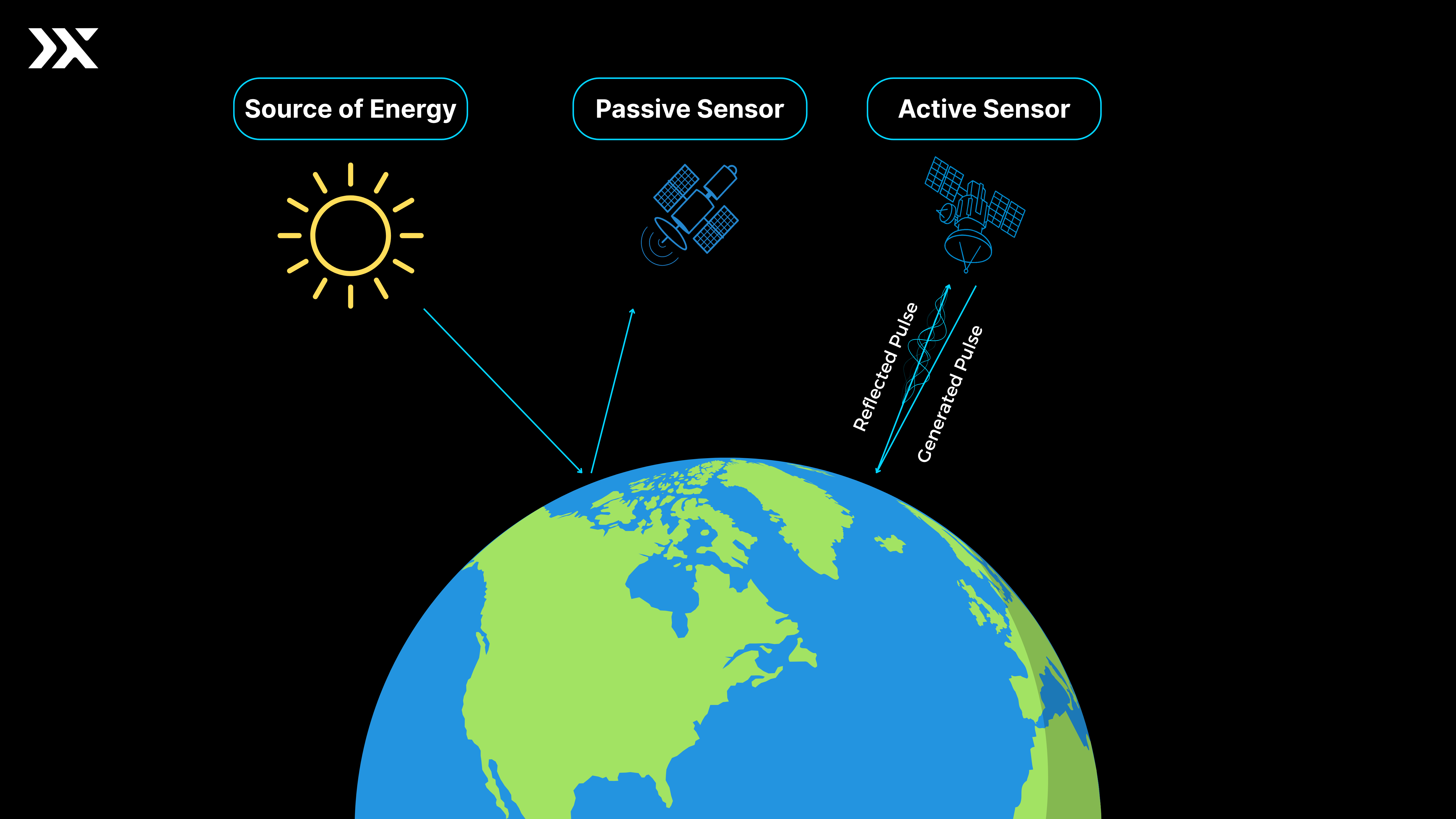
Because passive hyperspectral sensors depend on natural light, several factors influence data quality:
- Cloud cover,
- Time of day,
- Atmospheric conditions
As a result, careful acquisition planning and atmospheric correction are essential to ensure usable data.
Finally, like all remote sensing data, hyperspectral imagery must be preprocessed to correct for artefacts, calibration errors, and atmospheric distortions. Once refined, hyperspectral imagery becomes a powerful layer of intelligence, revealing spectral properties of the Earth’s surface.
1.4 Applications of Hyperspectral Imaging
HSI fundamentally changes how we observe, classify, and understand the Earth’s surface. Unlike conventional imaging systems that capture limited spectral bands, HSI captures hundreds of narrow, contiguous spectral bands across the electromagnetic spectrum, forming a rich three-dimensional data structure known as a hypercube. The key strength of this technology lies in its ability to acquire a complete spectral signature for every pixel in an image, enabling precise material identification and sub-pixel analysis.
Each pixel in a hyperspectral image contains a continuous reflectance spectrum, which can be used to characterise the physical, biological, or chemical properties of surface materials. This allows analysts to move beyond detecting “what is visible” to inferring “what it’s made of”—a critical distinction in applications where fine compositional details matter.
1.4.1. The Advantages of Hyperspectral Imaging
1.4.2. Unique Insights and the Advantages of Space-based Hyperspectral Imaging
- Material Decomposition at Pixel Scale: Spaceborne HSI can unmix materials within a single pixel, leveraging spectral and spatial cues to reveal subtle surface composition.
- Biogeophysical Parameter Retrieval at Scale: Provides global, repeatable measurements of chlorophyll content, leaf water status, mineralogy, and other critical traits.
- Early Detection Capability with Wide Coverage: Identifies early-stage crop stress, disease, or chemical contamination, while satellites ensure monitoring across entire regions and continents.
- Advanced Classification with Consistent Baselines: Enables detailed land cover and land use mapping, standardised across time and geography for long-term change detection.
- Access to Challenging Environments: Reaches remote, hazardous, or politically restricted areas where airborne campaigns are not feasible.
- Scalable and Cost-Effective Monitoring: Overcomes the limited scope and high costs of aircraft or UAV surveys by providing frequent, global coverage.
- Near Real-Time Change Tracking: Satellites capture dynamic processes (e.g., vegetation stress, water quality shifts) at the temporal resolution required for rapid decision-making.
1.4.3. Considerations in Hyperspectral Imaging
- Large Data Volumes: Require significant storage and transmission capacity.
- High Dimensionality: Traditional multispectral workflows are insufficient.
- Specialised Processing: Dimensionality reduction, spectral unmixing, and feature extraction are essential.
- Computational Demands: Advanced infrastructure and expertise are needed to transform raw data into actionable insights.
1.5. Summary
- Hyperspectral Imaging (HSI) captures hundreds of narrow, contiguous spectral bands across visible, near-infrared, shortwave infrared, and sometimes thermal regions, providing detailed spectral signatures for every pixel.
- HSI is based on the physics of electromagnetic reflectance, allowing identification of materials by how they absorb and reflect light.
- Key sensor characteristics include spectral bands, spectral resolution, and Full Width Half Maximum (FWHM), which determine the sensor’s ability to detect subtle material differences.
- Hyperspectral sensors are deployed on various platforms:
- Spaceborne satellites (e.g., Pixxel’s Firefly constellation) for large-scale monitoring
- Airborne systems for regional, high-resolution data
- UAV and handheld devices for local-scale, flexible studies
- HSI enables precise material identification and classification, revealing details not visible to traditional or multispectral imaging.
- Common applications include agriculture, mineral exploration, water quality monitoring, environmental assessments, urban planning, and defence.
- Due to the high volume and dimensionality of hyperspectral data, specialised preprocessing and analysis methods are essential to extract meaningful insights.
- Mastering these fundamentals provides a solid foundation for understanding the broad range of HSI applications explored in the following chapters.
2. Understanding Hyperspectral Data
Hyperspectral imaging produces large, information-rich datasets that require proper structuring, calibration, and preprocessing for accurate analysis. In this module, we break down the structure of hyperspectral data, the essential correction steps applied to it, and key preprocessing techniques that transform raw data into actionable insights.
2.1 Understanding Hyperspectral Data Cubes
2.1.1. What is a Hypercube?
A hyperspectral data cube, also known as a hypercube, is a three-dimensional array of data representing:
- X, Y – the spatial dimensions (rows and columns of an image)
- ℷ – the spectral dimension, consisting of hundreds of narrow, contiguous wavelength bands
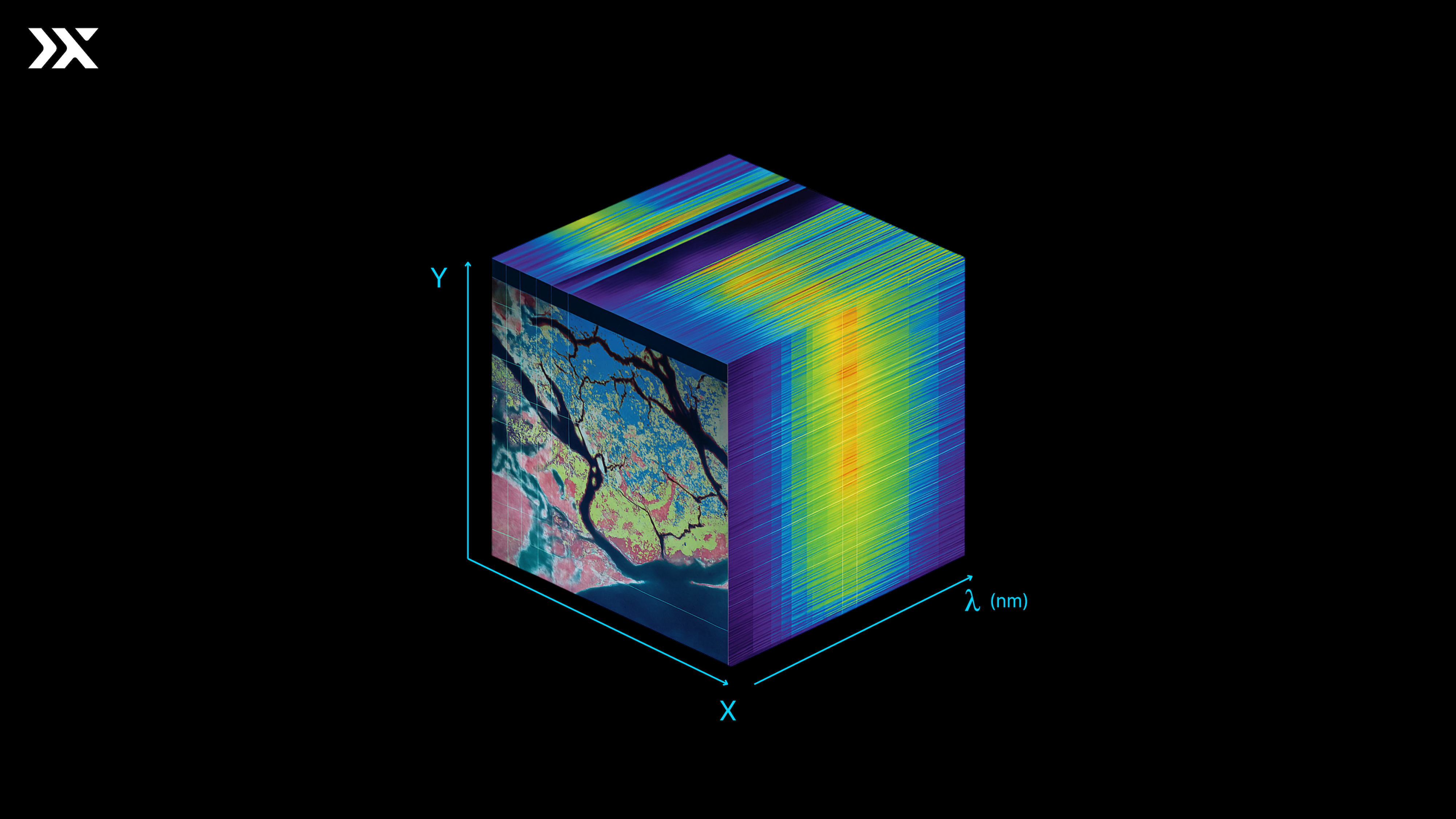
Each pixel in a hyperspectral image holds a complete spectral signature, enabling fine-grained material identification across a scene. Instead of a single colour value, a pixel in a hypercube contains a vector of reflectance values corresponding to the wavelengths captured by the sensor.
This structure supports both spatial and spectral analysis, answering questions about not only where something is but also what it’s made of.
2.1.2. Common file formats & metadata
Hyperspectral data is typically stored in formats that support multiple spectral layers and associated metadata.
2.1.3. Metadata in Hyperspectral Data
Metadata provides essential contextual information required for interpretation and processing. It often includes:
- Wavelengths and spectral bandwidths (centre wavelength, FWHM)
- Acquisition parameters (date, time, solar angle, viewing geometry)
- Sensor/platform information
- Radiometric calibration coefficients
- Spatial reference system and geolocation details
- Atmospheric model settings (if corrected)
Metadata is typically stored in .hdr files, sidecar XMLs, or embedded in formats like HDF5.
2.2. Radiometric & Geometric Corrections
Raw hyperspectral data must be calibrated and corrected to be scientifically meaningful. These corrections convert raw pixel values into accurate surface-level reflectance aligned with real-world coordinates.
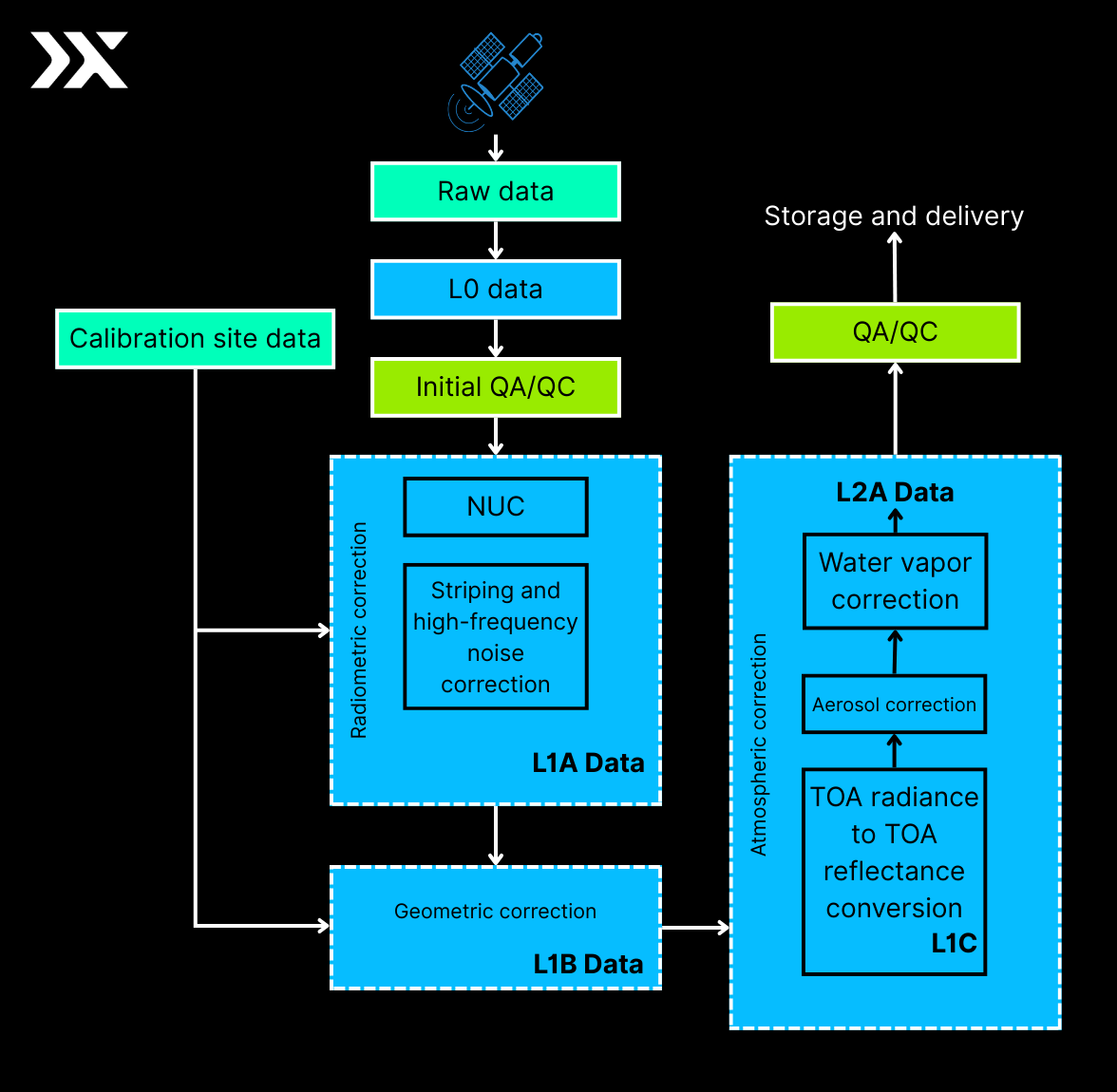
2.2.1. Radiometric Calibration (Sensor Level)
Hyperspectral sensors initially record raw data as digital numbers (DNs) corresponding to the intensity of light detected at each wavelength. However, these raw values are not directly usable for material identification or analysis.
Radiometric calibration transforms DNs into at-sensor radiance, a physical measurement of light energy (typically expressed in W·m⁻²·sr⁻¹·µm⁻¹). This step ensures that data from the sensor represents real-world light levels rather than uncorrected instrument responses.
Key elements of radiometric calibration include:
- Non-Uniformity Correction (NUC): Adjusts for differences in sensitivity between individual detector elements.
- Dark Current & Noise Correction: Removes background signal introduced by sensor electronics, thermal effects, or stray light.
- Conversion to Radiance: Applies sensor-specific calibration coefficients (gains, offsets) derived from pre-flight lab calibration.
At this stage, this data is considered Top-of-Atmosphere (TOA) radiance. This data accurately reflects the energy arriving at the sensor, but still includes distortions from the atmosphere and surface conditions.
2.2.2. Geometric Correction & Orthorectification (Scene Level)
To ensure hyperspectral imagery accurately represents real-world locations, geometric corrections must be applied to correct for distortions introduced by terrain, sensor geometry, and platform motion. These corrections enable the hyperspectral data to align precisely with geographic coordinate systems and other spatial datasets.
Key steps:
- Orthorectification: Corrects for terrain-induced distortions by incorporating a Digital Elevation Model (DEM). This ensures that features are represented in their true ground positions, accounting for variations in elevation, sensor tilt, and viewing angle.
- Georeferencing: Aligns the image to a known coordinate system using GPS and Inertial Measurement Unit (IMU) data collected during acquisition, or by using Ground Control Points (GCPs), identifiable features whose precise coordinates are known. This step establishes a spatial reference framework for the dataset.
- Image Registration: Ensures accurate alignment of multiple datasets, such as when comparing hyperspectral images from different dates (multi-temporal analysis) or integrating data from multiple sensors (multi-sensor fusion). Registration minimises spatial offsets between datasets.
Coordinate Systems and Projections
Once georeferenced, hyperspectral data is projected into a standardised map projection to ensure spatial consistency with other geospatial layers. A common projection used in remote sensing is the WGS84 (World Geodetic System 1984), which is the global standard for Earth mapping and GPS systems.
- Projections define how the curved surface of the Earth is translated onto a flat map. Using consistent projections (e.g., WGS84 UTM zones) ensures accurate distance, area, and positional analyses.
- Depending on the region of interest, a Universal Transverse Mercator (UTM) projection based on WGS84 may be used for finer local accuracy.
The result of geometric correction and projection is a geospatially accurate, orthorectified hyperspectral dataset that can be overlaid with other GIS layers (e.g., land cover maps, vector shapefiles) for spatial analysis and visualisation.
2.2.3. Atmospheric Correction Methods (Scene Level)
Hyperspectral data captured by satellite sensors are influenced by the atmosphere. Molecules such as water vapour, carbon dioxide, and ozone, along with aerosols, scatter and absorb incoming solar radiation. These effects distort the raw at-sensor radiance, making it unsuitable for direct quantitative analysis. Atmospheric correction removes these distortions, converting radiance to surface reflectance (a measure of the fraction of incoming light reflected by the surface itself).
A variety of models exist for atmospheric correction:
While these methods are widely used, Pixxel employs a customised, next-generation model, piSOFIT, to achieve high accuracy for its hyperspectral imagery.
Pixxel ISOFIT (piSOFIT) is Pixxel’s customised implementation of NASA JPL’s ISOFIT (Imaging Spectrometer Optimal Fitting) model, designed for precise atmospheric correction of Pixxel’s hyperspectral imagery. piSOFIT simulates how light interacts with the atmosphere and surface, then iteratively adjusts atmospheric and surface parameters to match observed radiance.
Key features:
- Radiative Transfer Modelling – Neural network–accelerated MODTRAN emulator (based on 6S) for fast, accurate simulations.
- Optimal Estimation – Refines aerosol and water vapour estimates using Bayesian priors.
- Uncertainty Quantification – Propagates sensor noise and model variability to produce pixel-level confidence metrics.
- Empirical Line Method – Scene-specific fine-tuning of reflectance retrievals.
Through this process, Pixxel produces two sequential reflectance products:
- L1C (TOA Reflectance): Normalised for solar illumination and geometry.
- L2A (Surface Reflectance): Bottom-of-atmosphere (BOA) imagery corrected for atmospheric scattering, absorption, suitable for quantitative science and operational applications.
2.3. Data Preprocessing and Calibration
Preprocessing is essential to reducing data volume, improving signal clarity, and preparing the data for analysis. It includes noise correction, band selection, and spectral normalisation.
2.3.1. Noise Removal
However, the sensitivity that makes HSI so powerful also introduces specific challenges. The signal can be susceptible to noise because it captures very narrow spectral bands. Variations introduced by the sensor’s electronics, stray light, or atmospheric interference can distort the data. Hyperspectral systems must maintain a high signal-to-noise ratio (SNR) to ensure accurate readings, meaning the actual surface spectral signal must be strong relative to the background noise. A low SNR can obscure essential features or even produce false readings.
.png)
Sensors may introduce noise through striping, sensor drift, or random interference. Common techniques include:
- Destriping filters: Correct systematic lines caused by sensor inconsistencies
- Bad band removal: Discard bands affected by water vapour absorption (~1400 nm, ~1900 nm)
- Smoothing filters: Apply techniques like Savitzky–Golay to reduce random spectral noise
2.3.2. Band Selection and Dimensionality Reduction
Hyperspectral images contain hundreds of spectral bands, but not all of them are useful for analysis. Redundant bands add noise, increase computation time, and may degrade model performances. To address this, dimensionality reduction techniques are used to retain the most informative spectral data while disregarding the rest.
.png)
Dimensionality reduction transforms high-dimensional data into a lower-dimensional space, preserving the essential information. Two primary approaches are used in hyperspectral analysis: feature engineering and feature selection.
Feature engineering involves mathematically transforming the original spectral data into a new feature space that highlights relevant patterns. This approach does not select existing bands, but instead projects or combines features to create new ones.
Techniques include:
- Parametric linear methods like Principal Component Analysis (PCA) and Partial Least Squares (PLS).
- Non-parametric linear methods for datasets without assumed distributions.
- Non-linear methods leveraging machine learning models to capture complex relationships in the data.
These methods aim to compress spectral data into fewer components that still represent the majority of the original variability.
Feature selection involves choosing the most informative original spectral bands while discarding less useful ones. Unlike feature engineering, this method retains the selected bands, making results easier to interpret.
There are three main types of methods:
- Filter methods: Evaluate features using statistical tests (e.g., Chi-squared, correlation coefficients) without involving machine learning models.
- Wrapper methods: Use machine learning algorithms to assess combinations of features based on model performance.
- Embedded models: Perform feature selection during model training, often using regularisation techniques (e.g., LASSO, Random Forest).
Feature selection helps avoid overfitting, reduces model training times, and improves generalisation to new data.
By applying these dimensionality reduction techniques, analysts can narrow down from 100+ bands to a manageable set of 10-50 relevant features, streamlining workflows while retaining critical spectral information for analysis.
2.3.3. Spectral Normalisation Techniques
Hyperspectral data is sensitive to external factors such as varying illumination, atmospheric effects, surface shadows, and sensor viewing angles. These factors can distort the raw reflectance values, making direct comparisons between scenes, or even between different areas within a scene, unreliable.
Spectral normalisation techniques are essential to adjust for these inconsistencies, ensuring that the spectral signatures used in analysis represent true material properties rather than external distortions.
Different normalisation methods transform spectral data to reduce brightness and slope effects while preserving the material-specific absorption features. These methods fall into linear and nonlinear categories depending on how they adjust the spectral data. Some examples include:
- Maximum and Minimum Reflectance Method (Linear): Scales each spectrum between its minimum and maximum reflectance values to correct for brightness variations; simple to apply but doesn’t adjust for shape distortions caused by terrain or atmospheric effects.
- Full-Spectrum Reflectance Method (Linear): Divides all reflectance values by the spectrum’s maximum reflectance, reducing scene-wide brightness differences while preserving spectral shape; can be sensitive to noise if the peak reflectance occurs in a noisy band.
- Zero-Mean Full-Spectrum Method (Linear Transformation): Centers spectra by subtracting the mean reflectance value across all bands, enhancing absorption features by removing overall brightness offset; useful for statistical analyses but alters absolute reflectance levels.
- Uniform Scaling Approach (Nonlinear): Applies a nonlinear scaling function to align spectra with varying brightness levels, effective in complex terrains with variable illumination; requires empirical tuning and may introduce artifacts if misapplied.
Spectral normalisation ensures that spectral signatures remain consistent across varying acquisition conditions such as changes in illumination, sensor viewing angles, or atmospheric effects. By reducing brightness-induced variance, normalisation enhances the reliability of classification and target detection algorithms, especially those that rely on the shape of spectral curves rather than absolute reflectance values.
This makes normalisation an essential pre-processing step in hyperspectral workflows, ensuring that the spectral information reflects true material properties rather than external acquisition factors.
2.4. Summary
3. Spectral Analysis Techniques
3.1. Basics of Spectral Signatures and Libraries
3.1.1. What is a Spectral Signature?
A spectral signature is the unique pattern of reflectance or absorption that a material exhibits across a range of wavelengths. Because different materials interact with light differently, each one has a distinct spectral fingerprint, which can be used to identify, classify, and analyse objects in hyperspectral imagery.
- Reflectance curves display how a material reflects light across the spectrum.
- These curves help differentiate between materials with similar visual appearances but different compositions (e.g., healthy vs. diseased crops, or different mineral types).
3.1.2. Spectral Libraries
A spectral library is a curated collection of reference spectral signatures, typically built from:
- Field measurements using spectroradiometers
- Laboratory spectrometry under controlled conditions
- Satellite or airborne data validated against ground truth
Spectral libraries are critical for:
- Material identification and classification
- Training classification algorithms
- Comparing scene spectra with known materials
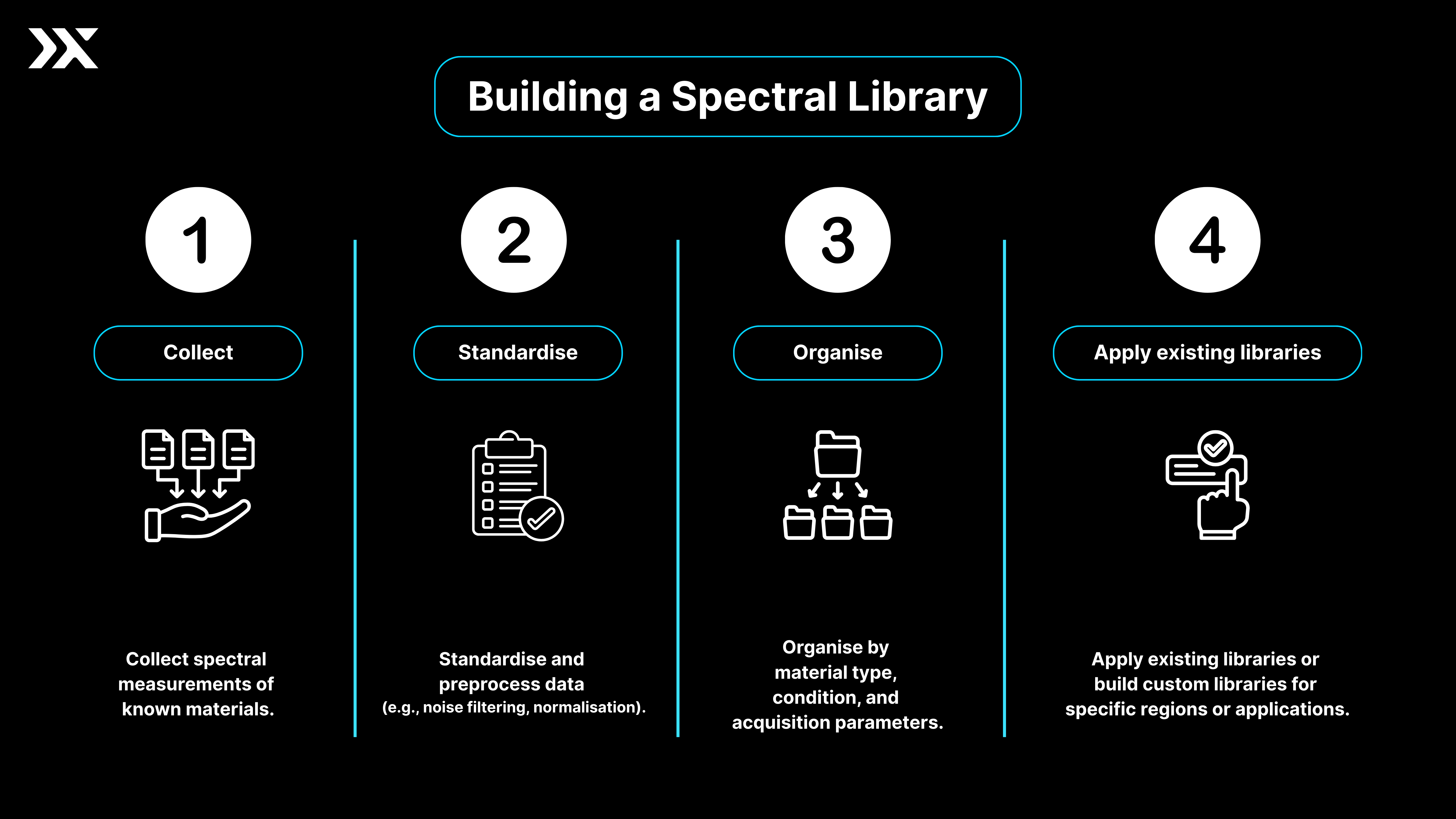
Interpreting Spectral Signatures
- Identify diagnostic absorption features at specific wavelengths.
- Consider external factors: moisture content, surface roughness, and atmospheric effects.
- Use spectral indices (e.g., NDVI, chlorophyll indices) to enhance interpretation.
3.2. Dimensionality Reduction
Hyperspectral datasets can contain hundreds of spectral bands, many of which may be redundant or noisy. Dimensionality reduction techniques are essential to simplify data, reduce computational load, and enhance meaningful features.
Principal Component Analysis (PCA)
- Transforms correlated bands into a smaller set of uncorrelated components.
- Captures the majority of data variance in the first few components.
- Helps visualise and separate key features in data (e.g., vegetation vs. soil).
Minimum Noise Fraction (MNF)
- An enhanced PCA that first estimates and minimises noise contributions before dimensionality reduction.
- MNF transforms maximise the signal-to-noise ratio (SNR), making it more suitable for hyperspectral data.
t-Distributed Stochastic Neighbour Embedding (t-SNE)
- A non-linear dimensionality reduction method.
- Effective for visualising high-dimensional data in 2D or 3D scatter plots.
- Preserves local relationships between data points, useful for pattern discovery and cluster analysis.
3.3. Classification and Target Detection
Classification in hyperspectral imaging refers to the process of assigning each pixel in an image to a specific class or material type based on its spectral properties. This is a core analytical step that transforms raw spectral data into meaningful thematic maps—such as vegetation species maps, mineral deposit maps, or land cover classifications.
Hyperspectral classification techniques broadly fall into two categories:
3.3.1. Supervised Classification
Supervised classification requires prior knowledge of the materials or classes present in the scene. It involves training the classifier using labelled datasets, where specific regions of the image (or spectral signatures) are pre-identified as belonging to a particular class.
Key Characteristics:
- Training Data Required: Needs accurate ground-truth or spectral library references.
- Higher Accuracy: Generally provides more precise classification results when good training data is available.
- Customisable: Can be fine-tuned to detect specific materials or conditions (e.g., a particular crop disease).
Common Supervised Methods:
- Spectral Angle Mapper (SAM): A physically intuitive algorithm that measures the angle between the pixel’s spectrum and a reference spectrum. Smaller angles indicate a closer match.
- Strengths: Robust against illumination differences.
- Limitations: Less effective when materials have subtle spectral differences.
- Support Vector Machines (SVM): A machine learning classifier that finds the optimal boundary (hyperplane) separating classes in a high-dimensional space.
- Strengths: Effective in high-dimensional hyperspectral data; handles non-linear separability.
- Limitations: Computationally intensive with large datasets.
- Random Forest (RF): An ensemble learning method using multiple decision trees. Each tree contributes to a “vote” for the final classification.
- Strengths: High accuracy; less prone to overfitting; handles noise well.
- Limitations: Requires careful tuning of hyperparameters like the number of trees.
When to Use Supervised Classification:
- You have reliable ground-truth or labelled training data.
- You need precise material-level classification (e.g., crop species mapping, mineral detection).
- The scene involves spectrally similar materials requiring finely tuned models.
3.3.2. Unsupervised Classification
Unsupervised classification, on the other hand, does not require prior knowledge of the classes in the scene. Instead, it relies on statistical algorithms to group pixels based on similarities in their spectral signatures, forming clusters that ideally correspond to real-world classes.
Key Characteristics:
- No Training Data Needed: Automatically groups pixels into clusters based on spectral similarity.
- Exploratory Tool: Useful for initial scene exploration and unknown environments.
- Subject to Interpretation: Clusters may not directly correspond to meaningful classes without further analysis.
Common Unsupervised Methods:
- K-Means Clustering: Partitions pixels into ‘k’ clusters by minimising within-cluster variance.
- Strengths: Simple and fast.
- Limitations: Requires defining the number of clusters (k) in advance.
- ISODATA (Iterative Self-Organizing Data Analysis Technique): An advanced clustering method that can automatically merge and split clusters based on variance and cluster sizes.
- Strengths: More flexible than K-Means.
- Limitations: Computationally heavier.
When to Use Unsupervised Classification:
- You lack sufficient ground-truth data.
- You’re performing exploratory data analysis in unfamiliar areas.
- You need to detect general land cover patterns or anomalies.
3.3.3. Supervised vs. Unsupervised: Choosing the Right Approach
3.3.4. Target Detection in Hyperspectral Imaging
Target detection is a specialised classification task focused on identifying specific, often rare, materials within a scene, even when they occupy only a small fraction of a pixel (sub-pixel detection).
Key techniques include:
- Matched Filtering (MF): Maximises detection of a known target signature while suppressing background.
- Adaptive Cosine Estimator (ACE): Measures similarity between a pixel’s spectrum and the target signature, normalising for background variability.
- RX Anomaly Detector: Identifies pixels that significantly deviate from the scene’s average spectral behaviour, useful when the target is unknown.
Key Considerations for Effective Classification & Target Detection
- Quality and representativeness of training data (for supervised methods).
- Dimensionality reduction to mitigate the “curse of dimensionality.”
- Noise removal and preprocessing to enhance signal clarity.
- Algorithm selection based on the scene complexity and computational resources.
- Post-classification validation using ground truth or independent datasets.
3.4. Summary
- Each material has a unique spectral fingerprint.
- Spectral libraries (field, lab, or satellite-based) enable material identification and comparison.
- Hyperspectral data is complex and has many redundant/noisy bands.
- Dimensionality reduction methods, like PCA, MNF, and t-SNE compress data while preserving key spectral information.
- Classification & Target Detection
- Supervised: Uses labelled data for precise mapping (e.g., SVM, Random Forest, SAM).
- Unsupervised: Groups pixels automatically for exploration (e.g., K-Means, ISODATA).
- Target detection methods (MF, ACE, RX) identify rare or subtle materials, even sub-pixel.
Spectral analysis transforms raw hyperspectral cubes into actionable insights by reducing complexity, enhancing interpretability, and enabling precise detection of materials and anomalies.
